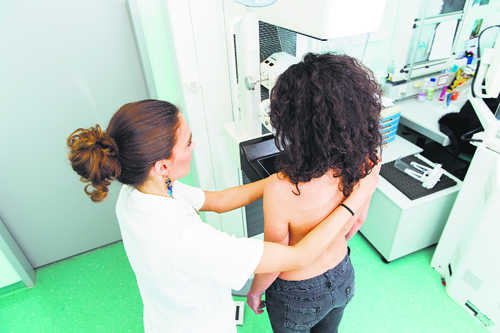
Dr Abhishek Puri
Breast cancer is one of the most common types of cancer in women. Common variants are called no-special type (NST) in contrast to rarer varieties referred to as the special type. Rare breast cancers have specific features that reflect their point of origin.
It would help us to understand normal tissue architecture first.
The breast is specific tissue overlying the chest muscles that produce milk (from the glandular tissue) supported by fat; it is organised into 15 to 20 sections, called lobes. These are further subdivided into lobules, where produced milk travels through a network of tiny tubes called ducts. These progressively form even larger ducts as they exit the skin in the nipple. The dark area of skin surrounding the nipple is called the areola; collectively called as nipple-areola complex.
Besides, breast tissue has connective tissues and ligaments for support; nerves for sensation along with blood vessels, lymph vessels, and lymph nodes.
Cancers can arise in any of the parts mentioned above because of unique genetic signatures and lifestyle factors. It is challenging to diagnose and treat rare breast cancers; hence it is preferable that patients seek treatment options from high-volume centres that have specialised knowledge to handle them.
Various types
Medullary: These occur in younger women or those with a faulty BRCA 1 gene (2-5 per cent). This type of breast tumour is also unusual because it contains white blood cells.
Mucinous: This type of cancer tends to be slower growing than other types and occurs more often in older women. It is less likely to spread to the lymph nodes. (1 to 4 per cent). It is thus called because this sub-type is made up of a large amount of "secretions".
Tubular: The cancer cells look like tubes when seen under a microscope. This type (2 per cent) occurs more often in older women.
Adenoid cystic: This type is also sometimes called cribriform cancer (less than 1 per cent). It is a type that is more often diagnosed in the salivary glands, but some occur in the breast tissue.
Other rarer sub-types (less than 1 per cent)
Metaplastic breast cancer occurs between the ages of 47 to 61. A type of lymphoma called breast implant-associated ALK-negative lymphoma can happen in a small number of women who have breast implants. Basal type breast cancer has particular genetic signature in the cells that involves p53 gene which is damaged (mutated) or lost. The cells make large amounts of a protein called cytokeratin 5/6. Cystosarcoma phyllodes (pronounced fill-oy-dees) and papillary cancers (they look like ferns) may occur in middle-aged women or older and is rarely cancerous with little or no chance to spread to the lymph nodes.
Angiosarcoma mostly affects younger women. It involves thickening, rashes and discolouration of chest wall and breast.
Another variant that affects the nipple-areola complex (especially nipple ducts) called as Paget's disease. It starts with scaly skin and persistent itching around the nipples. It may be associated with additional tumours within the breast and requires surgically removing the nipple-areolar complex.
Last but not least is the inflammatory breast cancer that mimics infection of the breast not responding to antibiotics. It is aggressive and can spread quickly through the lymphatic system. It was considered as fatal, but medical advancements have made it possible to have a better outcome than before. It is usually treated aggressively with chemotherapy followed by surgery and radiation therapy.
Although relatively rare, breast cancer can also be diagnosed in men, especially those over the age of 60 and present with a breast lump. The treatment options remain the same as women.
Affected individuals undergo a physical examination, mammograms and specific FDG-PET scans that light up tumours and other areas that may be involved. It helps in tumour staging which is the starting point for treatment. A biopsy is done to confirm the diagnosis.
Following this, these above tumours are usually treated in combination with surgery (either partial or complete removal, followed by chemotherapy or radiation therapy).
Sometimes, patients may undergo, neo-adjuvant chemotherapy, i.e. chemotherapy sessions before surgery. These sequences are determined from clinical trials that establish excellent evidence to approach them effectively. Breast may be reconstructed from an impact or tissue from your own body that improves cosmoses. It is true if the whole or part of the breast tissue has been removed.
High energy X-Rays kill these tumours and are delivered by a variety of techniques; e.g. intensity modulated radiation therapy under imaging guidance or volumetric arc therapy (VMAT). Modern radiation therapy is safe and effective as dose to normal tissues is minimised.
Known risk factors
- High-fat diet
- Obesity
- Late marriage
- Fewer children
- Inadequate breast feeding
Other factors
- Tobacco use
- Occupational hazards
- Exposure to environmental substances
- Outdoor air pollution
—The writer is a radiation oncologist, Fortis Hospital, Mohali



























